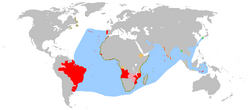Portuguese Empire facts for kids
The Portuguese Empire (Portuguese: Império Português) was the first global empire in history . It spread from South America to Africa, India and South East Asia. It began with the Portuguese exploration of the world during the 15th century and it lasted longer than all the other modern European empires. It lasted almost five centuries. This is longer than the Spanish, British, and French Empires.
The Portuguese Empire had trade with the following areas:
- Goa, Malacca and Southeast Asia
- China and Japan
- Spice Islands (Moluccas) and the Treaty of Zaragoza
- South Asia, Persian Gulf and Red Sea
- Sub-Saharan Africa
The 1890 British Ultimatum was an ultimatum by the British government, delivered on 11 January 1890 to Portugal. The ultimatum forced the retreat of Portuguese military forces from areas in Africa which had been claimed by Portugal, but which the United Kingdom occupied.
Contents
Fall
The Portuguese Empire, like the British, French and German empires, was fatally damaged by the two world wars fought in the 20th century. These European powers were pressured by the Soviet Union and the United States and by independence movements inside the colonial territories. By the end of the 20th century these colonial empires were history.
The rise of Soviet influence in the working class, and the cost of the Portuguese Colonial War (1961–1974), led to the collapse of the Portuguese Second Republic (Estado Novo) in 1974. The National Salvation Junta (Junta de Salvação Nacional) - was to end the wars and take Portugal out of its African colonies. These events made thousands of Portuguese refugees from Portugal's African territories.
Civil wars soon broke out elsewhere. After years of fighting, Portgual gave Macau to China in 1999.
Legacy
The seven former colonies of Portugal have Portuguese as their official language. They are members of the Community of Portuguese Language Countries with Portugal. Today Portuguese is one of the world's major languages. It is the language of Brazil, which is the largest country in South America.
Images for kids
-
The Conquest of Ceuta, in 1415, was led by Henry the Navigator and initiated the Portuguese Empire.
-
The 1494 Treaty of Tordesillas meridian divided the world between the crowns of Portugal and of Castile.
-
The Portuguese visited the city of Nagasaki, Japan.
-
Portugal was the first European nation to establish trade routes with Japan and China. A significant portion of the crews on Portuguese ships on the Japan voyage were Indian Christians.
-
Portuguese Fort, one of the best-preserved forts in Bahrain
-
Portuguese carracks unload cargo in Lisbon. Original engraving by Theodor de Bry, 1593, coloured at a later date
-
St. Francis Xavier requesting John III of Portugal for a missionary expedition in Asia
-
A map from 1574 showing the 15 hereditary captaincy colonies of Brazil
-
The Luso-Hispanic (or Iberian) Empire in 1598, during the reign of Philip I and II, King of Portugal and Spain
-
The Portuguese victory at the Second Battle of Guararapes ended Dutch presence in Pernambuco.
-
Portuguese India (1502–1961)
-
The Portuguese Cortes sought the disbandment of the United Kingdom.
-
Brazilian independence crippled the Portuguese Empire, both economically and politically, for a long time.
-
The façade of St. Paul's College in Macau, 1854
-
António de Oliveira Salazar sought the preservation of a pluricontinental Portugal.
-
Vasco da Gama's departure to India in 1497
-
Portuguese discoveries and explorations: first arrival places and dates; main Portuguese spice trade routes (blue)
-
The carrack Santa Catarina do Monte Sinai exemplified the might and the force of the Portuguese Armada.
-
The Se Cathedral in Goa, India, an example of Portuguese architecture and one of Asia's largest churches.
-
Portuguese remains an official language in Macau, alongside Chinese.
See also
 In Spanish: Imperio portugués para niños
In Spanish: Imperio portugués para niños
































